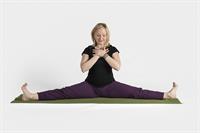Written by guest blogger, Deanna Nagle
 What if the aches, pains and decline of aging were completely preventable and reversible? What if you could release patterns of tight or weak muscles created by habit and trauma? This is the premise behind Somatic Yoga, a gentle form of exercise designed to assist us in releasing patterns of pain in the body. Somatic yoga, developed by Thomas Hanna in the 1970’s was strongly influenced by the methods of Moshe Feldenkrais – pioneer of Feldenkrais Method, which is used to improve human functioning by increasing self-awareness through movement. In addition, earlier methods such as the Alexander technique, developed at the turn of the century, helped inform the evolution of this practice.
What if the aches, pains and decline of aging were completely preventable and reversible? What if you could release patterns of tight or weak muscles created by habit and trauma? This is the premise behind Somatic Yoga, a gentle form of exercise designed to assist us in releasing patterns of pain in the body. Somatic yoga, developed by Thomas Hanna in the 1970’s was strongly influenced by the methods of Moshe Feldenkrais – pioneer of Feldenkrais Method, which is used to improve human functioning by increasing self-awareness through movement. In addition, earlier methods such as the Alexander technique, developed at the turn of the century, helped inform the evolution of this practice.
I was introduced to these gentle and healing movements through one of my favorite teachers, Tias Little, who incorporates somatic yoga into his warm-ups and cool-downs in yoga classes. Later, I practiced these techniques with visiting teacher Stephanie Snyder. After practicing with Stephanie during a full workshop of somatics, I fell in love with this style of yoga. Due to high stress and busy lifestyle, my nervous system craved this deeply calming and relaxing movement. In addition, I had several on going issues in my body that were not responding to physical therapy or general yoga classes. I decided to dive deeper into studying these techniques and offer them as part of my own classes from time to time, as well as in full-length workshops.
During a full-length workshops, students have a deeper experience with this retreat for the nervous system. Oftentimes due to illness, trauma, habits, aging, and stress, our bodies get locked into patterns,or samskaras, and our muscles forget how to relax or how to engage to support us. Somatic yoga helps by retraining the brain and the nervous system to let go of these patterns through small and gentle movements. This style of yoga is completely accessible to all ages and ability levels and the benefits of the practice can be experienced after just one session.
The benefits of somatic yoga are countless – from improving posture, decreasing pain, improving mobility, improved breathing, relieving headaches, shoulder, neck and back pain and much more. Thomas Hanna believed that most of our chronic pain stems from “sensory-motor amnesia” in which the sensory motor neurons of the voluntary cortex have lost some portion of their ability to control all or some of the muscles of the body. Hanna favors a technique called “pandiculation” in which muscles are gently contracted and slowly released to help retrain the nervous system and allow muscle tension to dissolve. This practice also emphasizes fluidity, like moving underwater, to gently lull the mind and body into a state of deep relaxation.
Who can benefit from Somatic Yoga? Just about everyone! We all lead stressful, busy lives, and we all have patterns of tension in parts of our bodies. Learn about the common muscular-skeletal patterns that distort our bodies, leading to pain and discomfort. Unlock those patterns through soothing and restorative movement leading to a state of calm and bliss!
I hope to see you at my workshop on June 22, 6:30-8pm!
I can’t wait!
This is a wonderful article. Thank you! for sharing such a great article.
Great! Thanks for sharing this useful information.